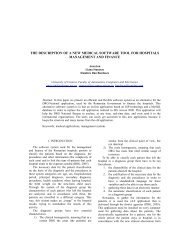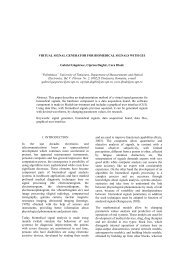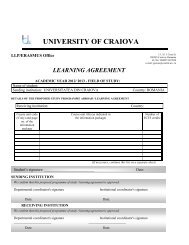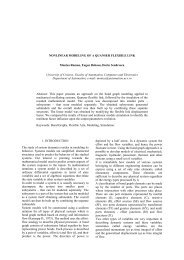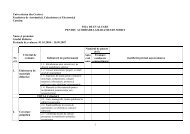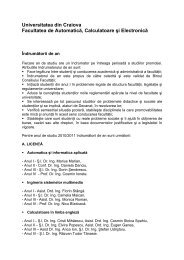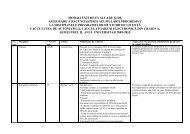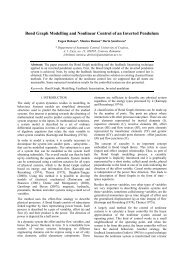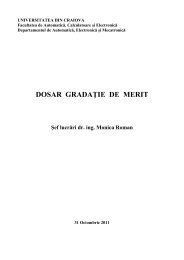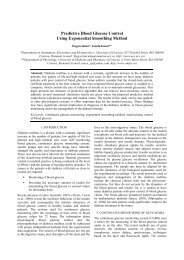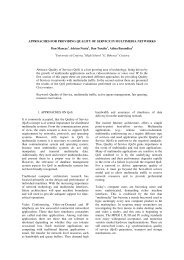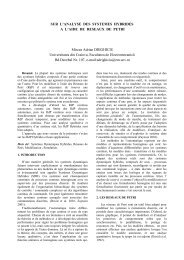FUZZY CONTROL FOR ROBOT'S DRIVINGS
FUZZY CONTROL FOR ROBOT'S DRIVINGS
FUZZY CONTROL FOR ROBOT'S DRIVINGS
Create successful ePaper yourself
Turn your PDF publications into a flip-book with our unique Google optimized e-Paper software.
<strong>FUZZY</strong> <strong>CONTROL</strong> <strong>FOR</strong> ROBOT’S <strong>DRIVINGS</strong>Anca PETRISORUniversity of Craiova, Faculty of Electromecanics, Romaniaapetrisor@em.ucv.roMarius POPESCUUniversity of Craiova, Faculty of Electromecanics, Romaniamrpopescu@em.ucv.roMihaela FLORESCUUniversity of Craiova , Universitary College of Drobeta Turnu Severin, Romaniamihaela@robotics.ucv.roAbstract: The paper presents the possibility tocontrol a robot arm using fuzzy systems. A three-phaseinduction motor is controlled using a vectorial controland fuzzy logic controllers with three and five linguisticlabels. It is realized an analogy between a PI controllerand a fuzzy controller. The simulations using such ofcontrollers highlighted the advantages of using a fuzzycontroller: increasing responding time of inductionmotor speed and respectively the statoric currentlimitation of the used induction motor.qI syyI sd8 rdq= 8 rdI I sdsqxI sxKey words: fuzzy logic controller, typical surface of thecontroller, control surface, Park transformation.1. MATHEMATICAL DRIVING MODELLet us consider a three-phase induction motorwith a s , bsand csthe stator phases and a r , brand crthe rotor phases (fig. 1a). The time variable electricalangle , defines the instantaneous position betweenmagnetic axes of asand arphases chosen as referenceaxes, and d axis of the orthogonal axes referencesystem d q. The angles s and rare the anglesbetween a stator phase respectively a rotor phase withd axis of the orthogonal reference system d q.b sb rc r6a 7 r r6 s6 r 7 sc sFig. 1a Explanatory for the position of the systemof statoric and rotoric axes for an induction motordqFig. 1b Explanatory for the position of reference systemrelated to rotor fluxwhere (x,y) is the axis system related to stator and(d,q) the axis system related to motor rotating field.The induction motor equations, without saturationaredasdbsUas = Rs ias; Ubs = Rs ibsdtdtdcsdarUcs = Rs ics; 0= + Rriardtdtdbrdcr0= + Rr ibr; 0= + Rr icr(1)dtdtwhere Rsand Rrare the resistances for one statorphase respectively one rotor phase; U mn , i mn , mnarethe voltages, the currents and the flux (m index denotesthe a, b or c phase and n index denotes the stator or therotor).The relations between fluxes and currents are givenby the equations (2) (Câmpeanu, 1998) where L as , Larare the inductances for one stator phase respectively onephase inductances rotor; L mas , Lmarare the mutualinductances between two stator phases respectivelyrotor phases; Lmrsis maximum mutual inductances.
42 Las Lmas Lmas Lmrs cos Lmrs cos( ) Lmrscos( )3 3 24Lasmas Las Lmas Lmrs cos( ) Lmrs cos Lmrscos( ) 3 3 bs 4 2Lmas Lmas Las Lmrs cos( ) Lmrs cos( ) Lmrscos cs 3 3 =ar 24 LmrscosL mrs cos( ) Lmrs cos( ) Lar Lmar Lmarbr3 3 cr42 Lmrs cos( ) Lmrs cos Lmrs cos( ) Lmar Lar Lmar3 324Lmrs cos( ) Lmrs cos( ) Lmrs cosLmar Lmar Lar3 3Park transformation turns the stator and rotor windingsinto orthogonal equivalent windings. Thus, the a s , bsand cswindings are changed by two equivalentwindings dsand q s , and the rotor windings a r , brandcrby the equivalent windings drand q r .Choosing a reference system related to the rotary fieldsuch asd sd = s and r = r = ps (3)dtdtwhere p s are the number of stator poles pairs and w r ,wsare the mechanical and electrical angular speed, theequations (1) becomes:d sd = s sq Rs isd + uddtd sq = s sd Rs isd + uqdtd rd = ( s p s ) rd Rr irddtd rq = ( s p s ) sq Rr irq(4)dtThe differential equation of the movement for a rigidcoupling isd2J = Me Ms = Me M0 K1K2 (5)dtwhere M0is the constant component part of the statictorque M s ; K1and K2are proportional constants; Meisthe electromagnetic torque ; is the angular speed. Withthe assumption that the static torque that depend of thesquare speed is neglected, the equation (5) (Popescu2002) becomesdJ = Me Ms = Me M0 K1 (6)dtThe electromagnetic torque Mecan be expressed bycurrentsMe = ps L m (isq ird isd i rq )(7)The relations between fluxes and currents in Park modelare sd = Ls isd + Lm ird = L i + L isq s sq m rq(2) rd = Lm isd + Lr ird rq = Lm isq + Lr irq(8)where- sd , sq , rd , rqare the stator and rotor fluxesalong the axes d and q ;- i sd , i sq , i rd , irqare the stator and rotor currents alongthe axes d and q ;- Lsand Lrare the inductivity of the stator and rotorwindings;- Lmis the periodical mutual inductivity between thestator and the rotor, such asLs = Las LmasLr = Lar LmarLm= 3/2 Lmrs(9)Chosen a reference position such as the axis d is alongthe rotor flux vector r (fig.1b), then the vectorialcontrol will allow the rotor flux regulation by controllingthe current i sd and the electromagnetic torque developedby the motor.If we consider an induction motor with short circuit rotor( ur= 0), and if the rotor flux vector is along d axis ofthe (d,q) axes system, then the q axis flux componentpart is null. r = rdq = rd rq = 0 . (10)and the equations (4) becomesd sd = s sq Rs isd + uddtd sq = s sd Rs isd + uqdtd rd = Rr irddt0 = ( s p s ) sq Rr irq(11)Replacing the fluxes in equations (11) by theirsexpression, these becomesdisddirdud = Rs isd + Ls s Ls isq + Lm s Lm irqdtdtdidisdrquq = s Ls isd + Rs isq + Ls + s Lm ird + Lmdtdt
disddi0= L rdm ( s p s )Lm isq + Rr ird + L r ( s p s ) Lr irqdtdtdisqdi rq0 = ( s p s)Lm isd+ L m + ( s p s)L i r ird+ Rr irq+Lrdtdt(12)and the electromagnetic torque isLmMe = ps rd isq. (13)LrThe most important perturbance for a driving systemis the static torque M s , for rotation movement,respectively static force F s , for translation movement.For driving is highlight a constant component part ofstatic force F 0 (bearing dry friction), a speedproportionally component (viscous friction) and anothercomponent, square speed proportionally.Static force for driving is2Fs = F0 + K1 v+ K2 v . (14)General equation for rotation movement, respectivelyfor translation movement (for speed value different fromzero) isddvMe= Ms+ J (15) Fe = Fs+ m (16)dt dtwhere Meand Feare electromagnetic torque,respectively electromagnetic force.2. <strong>FUZZY</strong> LOGIC <strong>CONTROL</strong>LERFor the robots control based upon driving motorspeed regulation, for example the robot arm, startingfrom movement equation (6) and the electromagnetictorque equation (7) it could be implemented a cvasi-PIstandard fuzzy controller (fig.2).7+-7eF e1-z -1KeeFKeKeKuR-FFig.2 Fuzzy logic controllerFKuKuA position transducer placed on the robot offersinformations about the reference angular speed p . Theoutput u of the speed controller will act on the referenceelectromagnetic torque, which is proportionally with thecurrent isqwhen the flux is invariable in time. Theamplifiers of the input and output variables F e , F e,Fusituated on the input and output of the fuzzy logiccontroller are called scale factors. They allow to changethe controller region of operation without modify itsstructure.The variables with an index n, are the normalizedvariables of the controller. Denotes with Tethesampling period, with e the speed error defined by thedifferencee(k T e) = p( kTe) ( k Te)(17)Li sand with ethe change of the error, then the output ofthe controller isisq ( k Te ) = isq ( k1) Te + u(kT e)The inference rules establish the behaviour of thecontroller and by defuzzification is selected onerepresentative crisp element.Using in fuzzy description of each input variable thefollowing three linguistic labels: N-negative, Z-zero, P-positive, defined by triangular and trapezoidalmembership functions, is easy to implement the fuzzystage (fig. 3 a, b).H(x)10,50H(x)10,5b sH(x10,50„N” „Z” „P”-1 0 1a)„N” „Z” „P”-1 0 1b)„N” „Z” „P”-1 0 1c)Fig. 3 Membership functions of input and outputvariables of fuzzy logic controllerThe same linguistic labels defined by singletonmembership functions are chosen for the output variable, u n , (fig. 3c). The rule base is created by takingaccount the pseudo-fuzzy properties of the PI quasicontinualcontroller.For calculation of the crisp isqvalue (thedefuzzification of the vague information), is not appliedthe Mean of Maxima method used when the membershipfunctions of output variables are singleton. In this case isused for defuzzification the Center of Area (COA)method. The rule-base is defined by the matrix (Yager etal. 1994).u ne nN Z PN N N Ze n Z N Z PP Z P Pe nKeKu n
with graphical representation presented in fig. 4a, if it isconsider a Mamdani controller and for the scale factorsFe, Feand F u , the values 100, 10 and 5.The typical surface of the controller corresponding tosome real outputs u , function of the inputs e andN e ,when these cover the base set, has two areas:- A peripherical, smooth parallel area with eand e , (fig.4a) axes that corresponds to a rangewhere one of the input variables are saturated.In this area the inference motor evaluates just one ormaximum two rules.- A second central area (in normalized coordinatesfig.4b)enand en[-1,1], that could be dividedin 4 dials and represents the proper central area ofthe controller.variable is very close of specified speed, the linguisticlabels Ns and Ps will be requested and because theirmembership functions are very close to Z (zero)linguistic label, the response of the controller will beslower. This thing needs the multiply with two of theoutput variable regarding its value obtained in the caseof the controller with three linguistic labels.NLNs1ZµPs-1 0 1PLe na)NLNsZµPsPL1a)-1 0 1Ke nµb)NLNsZPsPLb)Fig. 4 The control surface of fuzzy logic controller:a) in actual values; b) normalizedChosen a bigger number of linguistic labels (forexample five) the base-rule will be greater and the ratingtime will increase. If for controller with three linguisticlabels, the control is made by the factors scale, for acontroller with 5 linguistic labels, this is realized byintuition, by modifying the form and the distribution ofthe input or output membership functions on the base set.It is possible that, using an optimize proceeding byTaguchi method, (this consists in identifying the system,starting from its ramp response in open circuit), toappreciably reduce the number of the attempts forestablish the best control (Popescu 2000). For inputvariables enand enwill be chosen a uniformlydistribution of membership functions on base set (fig.5)and for the output un, the membership functions that iscorresponding to Ns (negative small) and Ps (positivesmall) linguistic labels are close to the membershipfunction of Z linguistic label.The control will be realized by intuition, known thatin such of cases the real output of the controller willreach a limiting value (of saturation). When the outputb)-1 -0.3 0 0.3 1Ke nc)Fig. 5 The graph of the membership functionsadjacent to input and output variablesThe control surface is presented in fig.6a(considering a Mamdani controller), on the base of theinference matrix.Ke nKu n NL Ns Z Ps PLNL NL NL Ns Ns Ze n Ns NL Ns Ns Z PsZ NL Ns Z Ps PLPs Ps Z Ps Ps PLNL Z Ps Ps NL PLThe characteristic surface of the controller, innormalized coordinates, is presented in figure 6b. Byanalogy to the controller with the base set consisted ofthree linguistic labels, there are an important number ofsurfaces and those surfaces corresponding to two andfour dials they are not smooth any more.
a)For the driving with the dates: L m =0,1126H,L r =0,1154H, p s =2, J=4.10 -3 kgm 2 , rd = 0,3Wb ,K 1 =2,5.10 -4 Nms (Popescu 2002) using a fuzzy logiccontroller with three linguistic labels and the scalefactors Fe, F e, Fuhaving the values 100, 10 and5, and considering the sampling period T e =10 -3 s, theonly values that are obtained for an unload start-up arepresented in fig. 9.b)Fig. 6 Control surfaces of fuzzy logic controllera) in actual values; b) normalized3. <strong>CONTROL</strong> DESIGNStuctural diagram of speed control presented in fig.2,in MATLAB/Simulink is like in fig. 7. Inductiondriving will be describe by movement equation andelectromagnetic torque equation, with a block structuraldiagram like in fig. 8, considering the fan static torque.Known that the control speed is realized actioning on thescale factors, for the synthesis of the controller will bechosen those scale factors witch offer a fast speedresponding time and an accepted starting current.Fig. 9 Driving unload start-up: up to * = 150rad s 1 :a) speed shape; b) stator current shapeFor the previous values of the scale factors andconsidering a type fan torque, then, for a start, the speedof the drive is a little bellow prescribed value and thecurrent is 8A (fig.10). An increase of scale factor Fuof the controller does not improve the performances (thecurrent will increase over the prescribed value). Sametime, the sensivity of the controller related to externalperturbances will increase, which make it practicallyuseless.Fig. 7 Structural diagram of driving speed controlwith fuzzy logic controller, in SimulinkFig. 8 Driving structural diagram, in Simulinkwith static torque linear depending of speed and alsowith square of speedFig. 10 Driving start-up (K 2 =0,1.10 -4 Nms)a) speed shape; b) stator current shape
A carrefull analysis in tri-dimensional space of thecontrol surface of fuzzy controller and PI conventionalcontroller (fig. 11a), shows that in dials 2 and 4 thedifference between controls udif(or between controlsurfaces corresponding to the controllers) is practicallynull (fig. 11b). The normalized control surfaces of fuzzylogic controller corresponding to four dials are not all ofthem smooth as in case of conventional PI controller butwith peaks in dials 1 and 3.Thus, the fuzzy logic controller with three linguisticlabels will behave like a conventional PI controller if it isnot used in the two dials (1 and 3).It can be developed a Sugeno fuzzy logic controller(called also procedural controller sincethe antecedent issymbolic and the consequent is a real constant or apolynomial expression), which offers the same responseas the conventional PI controller, in so called modalpoints (corresponding to triangular membershipfunctions). The inference matrix will be a symmetricalmatrix to its diagonal.In case of Mamdani fuzzy logic controller, ifmembership functions symetrical with respect to modalvalues would be chosen as for output variable,rectangular and identical as width then it would beobtained a linear interpolation between these modalvalues.a)a)b)Fig. 11 Control surfaces:a) corresponding to PI controller;b) corresponding to difference between controlsurface of fuzzy logic controller and PI controllerb)Fig. 12 Driving on-load start-up:a) speed shape; b) stator current shape4. CONCLUSIONSThe advantage of fuzzy logic controller willdisappear when comparing to a wind-up PI controller,knowing that this is working in a linear area.On the other hand, an wind-up PI-controller does notmake any problems when the output variable reach thesaturation value since the signal corresponding to thedifference between limited output and unlimited outputis once more fed to the controller for desaturation.When the input signal into controller is small (lowamplitude step signal or small prescribed speed-forexample 100 rad.s -1 ), the performances of the controllerare quite affected (the current decrease- fig.12b). Thecontroller saturates which allow a quicker response tostep signals.5. REFERENCESCâmpeanu, A., (1998). Introducere în dinamicamainilor electrice de current alternativ, EdituraAcademiei.Dubois, D., Prade, H. & Yager, R.R.,(Eds.) (1993).FuzzySets for Intelligent Systems, San Mateo, 575-581.IvVnescu, M., (2000). Arhitecturi neconvenionale deconducere a roboilor, Editura Universitaria.Popescu, M.C., (2002). Optimizari în instalatiile declimatizare utilizate în incinte cu degajari de nocivit$ti,Craiova.Popescu, M.C., (2000). Inteligen$ artificial$,Reprografia UniversitVWii C. BrincuXi, Tg. Jiu.Yager, R.R. & Filev, D.P., (1994). Essentials of FuzzyModeling and Control, New York.



